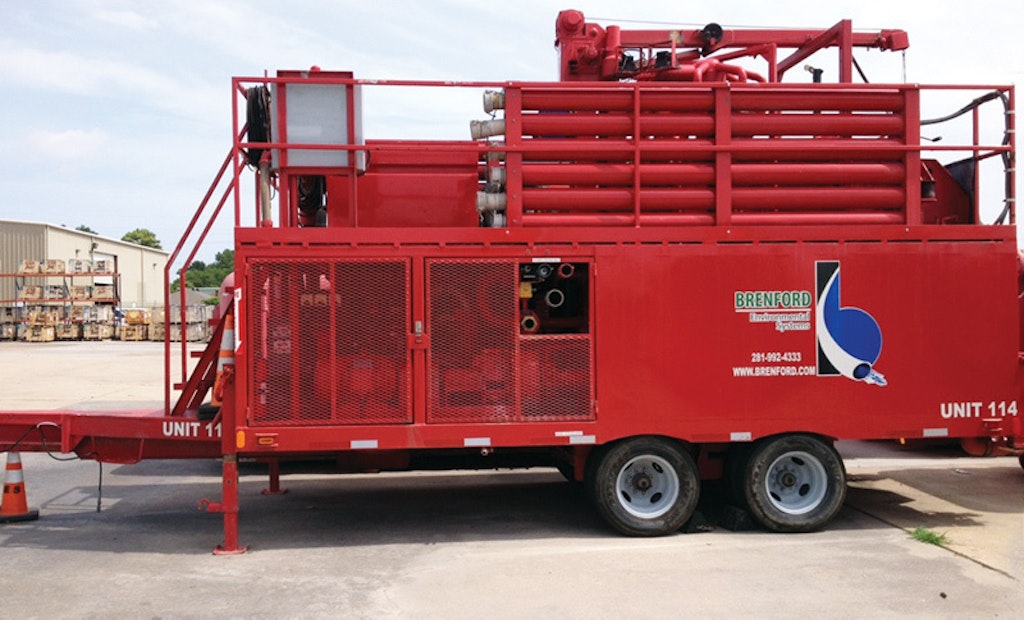
Interested in Plumbing?
Get Plumbing articles, news and videos right in your inbox! Sign up now.
Plumbing + Get AlertsNo water? No problem.
That’s the simplest way to explain what prompted Brenford Environmental Systems, a municipal and industrial pipeline cleaner based in suburban Houston, Texas, to invest in an MCT450 fluid-cleaning system made by Mud Technology International Inc.
Brenford, which specializes in cleaning hard-to-access large-diameter sewer lines, often works in remote locations where fire hydrants or other water connections are about as rare as a leak-proof manhole. In other cases, water is technically accessible, but crews are hampered by water-use restrictions or other regulations in environmentally sensitive areas.
So how does a pipeline cleaning company work without water? That’s where the MCT450, which the company purchased about four years ago, comes into play. The trailer-mounted unit pumps out graywater in the sewer line that’s being cleaned, traps small debris with a series of filter screens and pumps the remaining graywater to a proprietary system called the Sewer Hog. That machine then uses a powerful water jetter and downhole pump to scour the pipe and remove debris.
Any small debris that’s captured during this water-recycling process is typically taken to landfills for disposal; larger debris is removed by the Sewer Hog system and discharged into a watertight closed-loop, debris-containment system, where it’s later removed from the job site for proper disposal.
“This machine is ideal for areas with no water supply,” says Jimmy Stewart, Brenford’s vice president of sales. And if sewer flow volume is too low to support MCT450 operation, crews can either create a dam (inside the pipe) or use a flow-through plug that stops enough water to operate the recycling system.
“We also can take water from lakes and ponds, remove any debris that can clog the jetter nozzles, then use the recycled water to clean large-diameter pipes,” Stewart says.
The MCT450’s maximum capacity is 450 gpm. The unit measures 23 feet long, just more than 8 feet wide and 11 1/2 feet tall and weighs 20,140 pounds. Features include a 2,400-gallon tank, split equally for clean and dirty volume; submersed jet guns in each tank to stir contents; 36 square feet of filtering screens; 25 hp and 30 hp electric centrifugal pumps; easy-open clean-out valves; and remote-control operation.
A recent job in Conroe, Texas, vividly illustrates the MCT450’s value. Brenford won a bid to clean out about 10,000 feet of a remote, failing 72-inch-diameter sewer line that had to be repaired to make way for a residential subdivision. The section of the sewer was 3 or 4 miles from a paved road, and no water was available to jet the lines. But the MCT450 resolved that issue, Stewart says.
“We pulled water from the active sewer system, recycled it and pumped it to our Sewer Hog to clean the line,” he explains.
The unit provides Brenford with a distinct competitive advantage because it can perform cleaning jobs that other companies can’t. Moreover, it allows customers to sidestep the expense and hassle of having to either truck in water or use booster pumps and long hose runs to obtain water, he explains.
“Recycling water usually is much less expensive than hauling water and it allows for continuous operation,” he says. “It helps make us a more appealing option. Plus, it’s a 100 percent ‘green’ solution to an ever growing concern for municipalities. Water is a valuable resource that should be respected and reused when possible.”
Stewart says company officials first learned about the MCT450 at a trade show. It seemed like a perfect solution for upcoming projects in which water access was an issue. He also lauds the unit’s ease of operation, which requires just one person.
“We bought it for those projects and have been using it extensively ever since then,” Stewart says. “It’s more than paid for itself … I’d say we have it working about 100 days a year.
“It’s a great tool,” he adds. “I’d say that out of all the projects where we use the unit, about half would be impossible to do without it. And they also tend to be higher-profit-margin jobs because of the degree of difficulty.”





